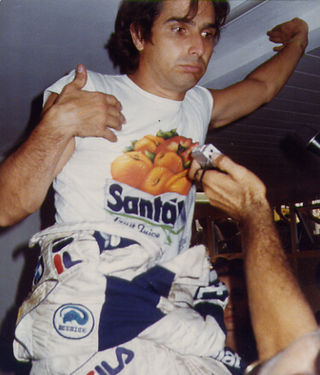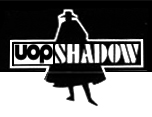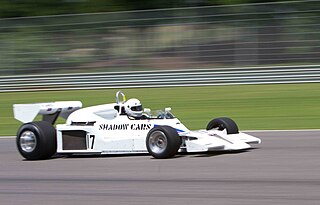
Riccardo Gabriele Patrese is an Italian former racing driver, who competed in Formula One from 1977 to 1993. Patrese was runner-up in the Formula One World Drivers' Championship in 1992 with Williams, and won six Grands Prix across 17 seasons.
Arrows Grand Prix International was a British Formula One team active from 1978 to 2002. It was known as Footwork from 1991 to 1996.

The 1977 Canadian Grand Prix was a Formula One motor race held on October 9, 1977, at Mosport Park. It was the 16th and penultimate race of the 1977 Formula One season.

The 1981 FIA Formula One World Championship was the 35th season of FIA Formula One motor racing. It featured the 1981 Formula One World Championship for Drivers and the 1981 Formula One World Championship for Manufacturers, which were contested over a fifteen-race series that commenced on 15 March and ended on 17 October. The 1981 South African Grand Prix, as a non-championship race due to difficulties from the ongoing FISA–FOCA war, was open to Formula One entrants but was not part of the World Championship.

The 1980 Formula One season was the 34th season of FIA Formula One motor racing. It featured the 1980 World Championship of Drivers and the 1980 International Cup for F1 Constructors, which were contested concurrently from 13 January to 5 October over a fourteen-race series. The season also included one non-championship race, the Spanish Grand Prix.

The 1978 Formula One season was the 32nd season of FIA Formula One motor racing. It featured the 1978 World Championship of F1 Drivers and the International Cup for F1 Constructors, contested concurrently over a sixteen race series which commenced on 15 January and ended on 8 October. The season also included the non-championship BRDC International Trophy.

Keith Jack Oliver is a British former Formula One driver and team-owner from England. He became known as the founder of the Arrows team as well as a racing driver, although during his driving career he won both the 24 Hours of Le Mans race and the Can-Am championship. Oliver was also the second person to complete the informal triple Crown of endurance racing.

Johannes Antonius "Jan" Lammers is a Dutch racecar driver, most notable for winning the 1988 24 Hours of Le Mans world endurance race, for Silk Cut Jaguar/TWR; after four seasons in Formula One racing, from 1979 through 1982, for the F1 teams of Shadow, ATS, Ensign and Theodore, respectively. After a world-record setting ten-year hiatus, Lammers made a brief Formula One comeback, for two races, with team March in 1992. Aside from racing in these two of the highest leagues of global auto-sports, Lammers has raced in an exceptionally wide number of racing series and competitions, domestic and abroad, over four decades.

Danny Ongais was an American racing driver.
Ensign was a Formula One constructor from Britain. They participated in 133 grands prix, entering a total of 155 cars. Ensign scored 19 championship points and no podium finishes. The best result was a 4th place at the 1981 Brazilian Grand Prix by Marc Surer, who also took fastest lap of the race.

Shadow Racing Cars was a Formula One and sports car racing team.

The Alfa Romeo 177 was a Formula One car used by the Alfa Romeo team during the 1979 Formula One season, debuting at the 1979 Belgian Grand Prix. The 177 marked Alfa Romeo's return to Formula One, 28 years after winning the World Drivers' Championship titles in 1950 and 1951.
Formula One sponsorship liveries have been used since the 1968 season. Before the arrival of sponsorship liveries in 1968 the nationality of the team determined the colour of a car entered by the team, e.g. cars entered by Italian teams were rosso corsa red, cars entered by French teams were bleu de France blue, and cars entered by British teams were British racing green. Major sponsors such as BP, Shell, and Firestone had pulled out of the sport ahead of this season, prompting the Fédération Internationale de l'Automobile to allow unrestricted sponsorship.

The Arrows A1 was the car with which Arrows Grand Prix International competed in the 1978 and 1979 Formula One seasons. It replaced the Arrows FA1, which was banned by the London High Court on 31 July 1978 after a legal protest from the Shadow team on the grounds that it was a carbon-copy of the Shadow DN9. Arrows anticipated that they would lose against Shadow and designed and built the A1 in under 60 days whilst the court case was being heard. Hence Arrows were able to present the Arrows A1 to the press just three days after the court case ended and did not miss any races.

The Arrows FA1 was a Formula One car used by the Arrows Grand Prix International team during the first half of the 1978 Formula One season.

The Shadow DN8 was a Formula One car used by the Shadow team during the 1976, 1977 and 1978 Formula One seasons. Driven by Alan Jones, it won the 1977 Austrian Grand Prix, Shadow's only Grand Prix victory.

There have been seventeen Formula One racing drivers from the Netherlands who have taken part in Grand Prix races since 1952. Max Verstappen is the most successful Dutch driver to date, as the only one to have won a Formula One World Championship, to have won a race, or to have taken a pole position.

The Penske PC4 was a Formula One car used by Team Penske during the 1976 and was driven to victory in that year's Austrian Grand Prix by John Watson, scoring the last win for an American-licensed constructor in a F1 race. It was used for most of the following season by ATS Racing and Interscope Racing also used the PC4 for two races that year.
Don Nichols was the founder and former principal of the Shadow CanAm and Formula One racing team.
















